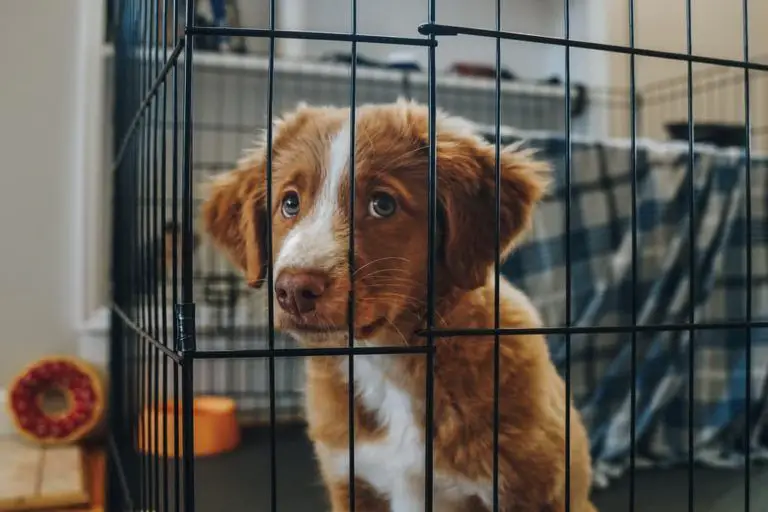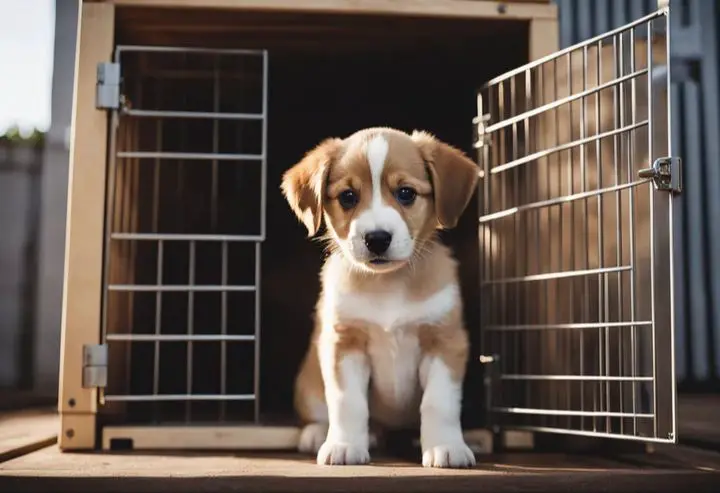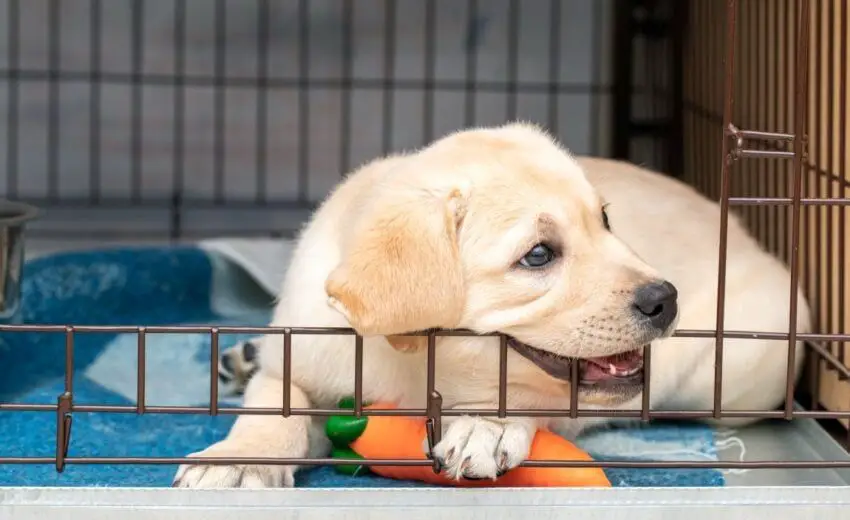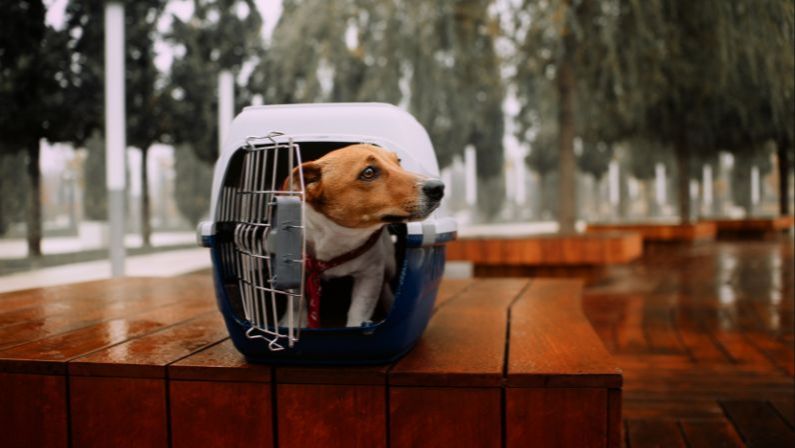Introduction
Crate training is an important part of raising a happy, well-adjusted dog. Crates provide dogs with a safe space to relax and sleep. They also help with potty training and preventing destructive behaviors when you can’t supervise your pup. However, it’s common for dogs to cry and protest when first introduced to crate training. As heartbreaking as it is to listen to puppy cries, responding to them can reinforce the behavior and draw out the training process. Knowing when to respond and when to ignore the crying is key to crate training success.
Why Dogs Cry in Crates
Dogs often cry in their crates for a few common reasons. The main cause is anxiety or stress. Being confined in a crate can be scary for a dog at first. They feel trapped and isolated. Dogs are social, pack animals, so being suddenly left alone in an enclosed space triggers their distress. Puppies especially haven’t learned to be alone yet. Dogs may also cry when they have pent up energy and are bored. Or they need to go potty. Crying can become a learned behavior to get your attention. Understanding why your dog is crying will help you address the underlying issue.
Should You Respond to the Crying?
Deciding how to respond when your puppy cries in their crate is a common dilemma for many dog owners during crate training. There are pros and cons to both responding and not responding.
On one hand, responding when your puppy cries can reinforce the behavior by teaching them that crying will get your attention. This can lead to more frequent crying in the future. It also prevents your puppy from learning to self-soothe and be comfortable in the crate alone.
However, completely ignoring crying can be stressful for puppies, especially very young ones or those new to crates. Puppies may see crates as confinement and crying is their way of expressing fear or discomfort. Not responding could increase anxiety over time.
The best approach depends on your individual puppy’s age, temperament and crate training progress. Finding a middle ground – providing some response while not overly reinforcing the crying – is usually ideal. Your reactions can become briefer over time as your puppy adjusts.
Tips to Reduce Crying

There are a few ways to help reduce crying when crate training a puppy. Start by making the crate as comfortable and inviting as possible. Place a soft blanket and some favorite toys inside the crate so the puppy has something familiar to cuddle up with. Consider using a snuggle toy that mimics the feel of a littermate or playing soft music to help soothe the puppy when left alone. You can also try feeding the puppy meals inside the crate and allowing brief naps in the crate throughout the day so it becomes a positive space, rather than only being confined there at night. Just a few small tweaks to make the crate cozy can go a long way in reducing those initial cries of protest.
When to Take Puppy Out
While it’s generally not recommended to give in to your puppy’s crying and take them out of the crate, there are some exceptions. If your puppy is young (under 4 months) and it has been over 2 hours since they last went potty, it’s reasonable to take them out for a bathroom break. Puppies have small bladders and limited control, so you don’t want them to be forced to go potty in the crate.
Additionally, if your puppy is showing signs of severe distress like nonstop crying, howling, or panting, you may need to intervene. Excessive stress is unhealthy for a young pup. Take them out, soothe them, then try again in a little while. But be careful not to reinforce the crying behavior.
Outside of bathroom breaks or rare occasions of extreme upset, resist taking your puppy out when they cry. This will reinforce the behavior and make crate training more difficult.
How to React
It’s important to stay calm and not get frustrated when your puppy cries in the crate. Responding angrily can make the puppy more stressed. Instead, wait for moments of quiet, even just a pause in whining, then reward those breaks in crying by giving praise, treats, and attention.
Make sure not to let the puppy out of the crate while crying, as this rewards the behavior. Only open the door when quiet. Then calmly praise and give a treat. This teaches the puppy that being quiet in the crate leads to rewards.
You can also try distracting with a food puzzle toy tossed in the crate or a favorite chew. Anything engrossing to redirect attention. But don’t give in and open the door if the crying persists. Be patient and consistent.

Over time, the puppy will learn that the crate is not scary and crying does not lead to being released. Crate training takes diligence, but staying calm and rewarding quiet moments sets up good habits.
Setting a Schedule
Setting a clear and consistent schedule is critical when crate training a puppy. Puppies need 18-20 hours of sleep per day, so having scheduled nap times and a set bedtime routine will help your puppy learn to settle in the crate.
Aim to have your puppy nap in the crate 1-2 hours, then have 1-2 hours of supervised playtime when they’re awake. Puppies under 3 months may need naps every 30-60 minutes. An enforced nap schedule prevents overtired puppies from becoming hyperactive and stressed.
Establish a relaxing bedtime routine such as taking your puppy outside to potty, allowing calm playtime, then putting them in the crate with a treat. Try to avoid stimulating play right before bed. Keep lights low, and consider playing soft music. Over time, your puppy will learn to settle for bed once this routine begins.
Having a consistent schedule with scheduled crate times teaches your puppy that the crate is a calm place for sleep and rest. This will reduce crying and resistance over time.
Crate Games
Transform a puppy’s perspective on the crate from a scary jail into a fun hangout through positive association games. Make the crate extra cozy with blankets, chew toys, and treats, so the pup starts to see it as their own private den for napping and relaxing. Feed all meals inside the crate and toss treats in whenever the pup goes in to create excitement around entering on their own. Start with very short sessions, like 10 seconds, and reward calm behavior, gradually extending the duration. Play crate games like hiding treats under blankets for them to find or tossing kibble inside for them to catch. The goal is to make the crate an awesome place they can’t wait to spend time in.

When to Call a Professional
If your puppy continues to cry excessively in the crate despite your best training efforts, you may need to seek professional help from a certified dog trainer or behaviorist. Here are some signs that it’s time to bring in a professional:
- Your puppy cries for more than 30 minutes when first crated or left alone and shows no improvement over 2-3 weeks of consistent training.
- The crying escalates into panic attacks, howling, or self-injury attempts.
- Your puppy continues to soil the crate despite correct sizing and frequent opportunities to relieve themselves.
- Lack of sleep and constant crated crying is creating stress for your family.
A professional trainer can assess your puppy’s behavior and help develop a customized crate training plan. They may recommend changes to the crate setup, schedule, positive reinforcement methods, or introduce calming aids if separation anxiety is suspected. If the crying persists long-term, medications may be prescribed in extreme cases. Don’t hesitate to seek outside help if you’ve diligently followed training advice without success.

Conclusion
In summary, you shouldn’t ignore a puppy who is crying for attention during crate training. It’s important to respond to their needs in a calm and reassuring way to help them adjust. However, you also don’t want to reinforce crying behavior, so it’s best to wait until the puppy settles down before letting them out.
Be patient and stick to a schedule. Provide plenty of exercise, toys and treats in the crate. Use crate games to help build a positive association. If the crying persists, call a professional trainer or behaviorist for additional advice.
With time and consistency, your puppy will get more comfortable being left alone in their crate for periods of time. Crate training is an important process that develops confidence and provides a safe space for your dog when done properly.